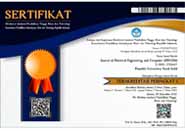Rancang Bangun Alat Gerak Jatuh Bebas Berbasis Arduino Uno Pada Praktikum Fisika
Authors (s)
(1) * Julie Cynthia Rante
 (Universitas Katolik De La salle Manado)
(Universitas Katolik De La salle Manado) Indonesia
(2) Ryan Laksmana Singgeta (Universitas Katolik De La salle Manado)
Indonesia
(3) Chrysantus M.M. Padachan (Universitas Katolik De La salle Manado)
Indonesia
(4) Randi Koyongian (Universitas Katolik De La salle Manado)
Indonesia
(*) Corresponding Author
AbstractFree fall motion is a falls down movement of an object due to the influence of the earth's gravitational force without any other significant forces affecting the movement. In free fall, the acceleration of an object is always constant and heading downward, and its value is about 9.8 meters per second squared (m/s²) on the Earth's surface. The implementation of free fall motion technology is expected to help students in doing their basic physics practicum so that observations is no longer done manually using a stopwatch. In addition, with this teaching media, the measurement data will be more constant in value because it has been arranged in the system, so that the results will be more accurate. The implementation of this free fall motion media is used to measure the travel time of an object, its speed and gravity value during free fall from a height of 60 cm and 30 cm. The travel time can be determined using a timer of an Arduino Uno and an Infrared Sensor that will be detected and read when there is an object passing by. Based on experiments that have been carried out at a height of 60 cm using ping pong ball, large marble, and small marble, the obtained value of gravitational acceleration is almost the same as the average value of gravitational acceleration measured namely 9.99, 10.00, and 10.24 m⁄s2 respectively. At a height of 30 cm, using the same objects, the obtained value of gravitational acceleration is 10.62 m⁄s2 . |
Keywords
Full Text: PDF
Refbacks
- There are currently no refbacks.
Copyright (c) 2023 Julie Cynthia Rante









